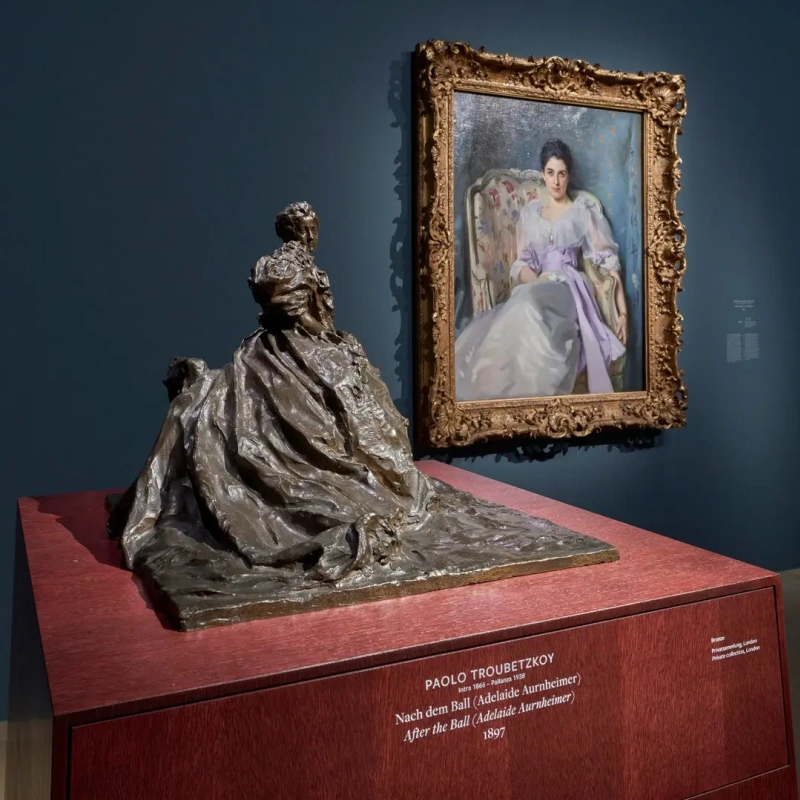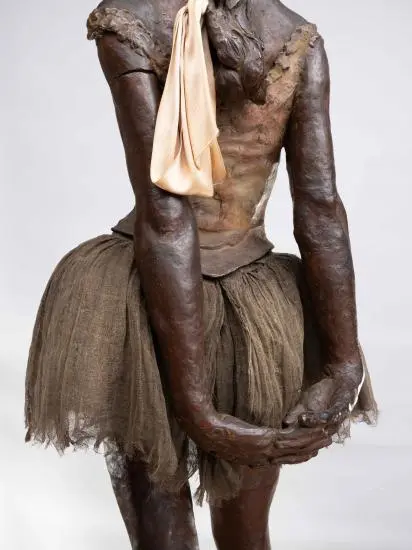Systematic thin. education is not received. He was educated, lived and worked abroad - in Milan from 1885, 1898 in Paris, occasionally bumping into Russia. In 1898-1906, the Professor of the Moscow school of painting. In 1914-20 he lived in the United States, then returned to Paris, 1932 and lived in Italy. Participant of exhibitions from 1886. The representative of impressionism, was at one time close to a circle "World of art". Sculptural portraits ("Tolstoy", 1899; "M. Tenisheva", 1899; "Witte", 1901; "C. Botkin", 1906), genre statuettes ("the Moscow cabby", 1898; "Leo Tolstoy on horseback", 1900; "Girl with dog", 1901) and other works. The author of the famous equestrian monument to Alexander III in St. Petersburg (1900-09).
Pavel Petrovich troubetzkoy was born 16 Nov 1866 in Italy, in Intra, on Lago Maggiore, in the estate of their parents. His father - a Russian Prince Pyotr Sergeyevich troubetzkoy, mother - American. Since eight years he is fond of sculpture and under the influence of his brother Pietro, a decorative painter, takes the first sculpture for the puppet theatre; two years later took lessons from painter D. Ranzoni. Serious training in sculpture began in Milan in 1884 in the Studio Barkali, and then E. Bazarro. However, systematic art education p. P. Trubetskoy, and has not received, but a rare talent and will contributed to its success.
In 1886 the young sculptor first introduced his work - a statue of a horse - the exhibition in Brera (Italy) and then of his works appear at exhibitions in France and America. He sculpts portraits, is animalistic plastics, trying force in monumental sculpture. In 1891, taking part in competitions for monuments to Garibaldi and Dante.
In 1897 troubetzkoy arrives in Russia, the homeland of his father. Captured by new impressions, the sculptor is working hard and soon began to teach at the Moscow school of painting, sculpture and architecture.
Bronze sculpture "the Moscow cabby" (1898, RM) - the first work performed in Russia. Genre composition, it would seem, is traditional in the story. Such domestic scenes are not met in the works of Russian sculptors - E. A. Lanceray and L. V. Posen. Trubetskoy was the embodiment of the first Russian impressions, without contemplative etnograficheskie, with disarming sincerity, a special plastic expressiveness soft, "flowing" forms.
Appeared in the exhibitions of the works of troubetzkoy has drawn sharp criticism from the conservative circles of the St. Petersburg Academy, who saw in his pioneering technique violation of the "classical" canons, and drew vnimanie advanced representatives of the Russian public, the artistic intelligentsia. Sculptor meets and gets with I. E. Repin, I. I. Levitan, V. A. Serov, F. I. Shalyapin. A great friendship bound Trubetskoy to L. N. Fat. The sculptor led to a lively sympathy of the writer. According to the testimony of Secretary L. N. Tolstoy - V. Bulgakov, "sculptor Paolo troubetzkoy... belonged to the favorites of Leo Tolstoy... He loved his simple open soul, truth, hatred of the secular conventions, love for animals, vegetarianism". Leo willingly posed to him and talked with him in the Studio of the sculptor and at Yasnaya Polyana.
Bust Of L. N. Tolstoy (1899, RM) and the statuette ". Tolstoy on horseback" (1900, RM) acquire worldwide fame. The serenity and wisdom, tolerance for bigotry and hypocrisy, simplicity and generosity revealed a sculptor in the distinctive character of the great Russian writer.
In 1900 the works by p. P. Trubetskoy exhibited in the Russian section at the world exhibition in Paris. The portraits of L. N. Tolstoy, L. Golitsyn and the group "the Moscow cabby" Trubetskoy, along with father Rodin is awarded the highest award - "Grand prize".
Then followed a series of portrait statuettes, characterized by spirituality and unique personality characteristics: artistically elegant and internally agitated Levitan (1899, RM), inspired by F. I. Chaliapin (1899-1900, RM), cheerful, good-natured Sergei Botkin (1906, RM). Sculptural works by p. P. Trubetskoy colourful art techniques: the picturesque movement and with the clarity of plastic forms, the desire to avoid flat and smooth, inert surfaces. In this mobility, walking as if from the depths of the scene reveals intimate mental model face.
Acute powers of observation, poetry, softness of modeling is particularly inherent in the female portraits. Eye-catching ball gown, M. K. Tenisheva (1899, RM), aristocratic Golitsyn (1911, State. art Museum of the BSSR), "Mother and child" (1898, state Russian Museum, state Tretyakov gallery), "Mother and son" (1901, RM), charismatic model Dunya (1900, RM) - all these works are original compositional and artistic techniques.
Special lyricism steeped in children: "Children. Nikolai and Vladimir Trubetskoy" (1900, RM), "Girl with a dog (Friends)" (1901,RM). A kind of psychologism - in the animal sculptor's works. Penetration differ such work of the sculptor, as "the Dog" (1899, TG), "Horse with foal" (1899, Smolensk regional Museum of local lore), "Siberian husky" (1903, RM), "the Horse under the saddle" (1898, RM).
In 1899-1909 he years the sculptor working on a monumental statue of Alexander III. This was built a special workshop-pavilion of glass and iron, on Staro Nevsky Prospekt, near the Alexander Nevsky Lavra. In the preparatory phase, Trubetskoi was created eight small-size models, four life-size, and two in the scale of the monument itself.
Out the winner of the competition in 1900 for the monument to Alexander III, troubetzkoy, has paid little attention to the comments of the Commission on the construction of the monument. Witte in "Memories" laments the "quarrelsome nature" of the sculptor. Troubetzkoy, obviously, did not take into account the opinions of the Grand Duke Vladimir Alexandrovich, who saw in the "model Trubetskoy a caricature of his brother." However, the Dowager Empress, satisfied explicit portrait likeness, contributed to the completion of the work on the monument.
The monument to Alexander III was significantly different from many of the official Royal monuments; the sculptor was far from the idealization, the desire for ostentation.
... on horseback tulostoma,
In the ground visnovska, the emphasis of hooves,
Half asleep, the excitement is unavailable
Motionless, and holding the bridle, is, -
expressed V. Y. Bryusov's poem "Three idol" their impressions from the image of "my warming above the crowd" of the autocrat.
Amazingly pinpointed the idea of the monument to Ilya Repin: "Russia, crushed by the weight of one of reactionary kings, going backwards".
As with many works that are clearly embodied artistic credo, saying that "the portrait should not be a copy. In clay or on canvas I convey the idea of the person, the common characteristic that I see in him." Regardless of the degree of authenticity of the words attributed to Trubetskoy - "don't do politics. I painted one animal to another," the monument evokes a feeling dull oppressive forces. A. Benoit noted that this feature of the monument "is not due to just luck of the master, but a deep understanding of the artist's task".
Even before the opening of the monument sculptor felt unfriendly attitude on the part of many members of the Royal family and senior officials. Nicholas II wanted to move the monument to Irkutsk, "send him to Siberia, away from their offended sons eyes", and in the capital to erect another monument. Witte says that the sculptor did not even receive invitations to the inauguration of the monument and arrived in St. Petersburg later.
Fell out of favor to the authorities and deprived of the opportunity to work on a new big order, Trubetskoi went abroad.
From 1906 to 1914, while in Paris, he creates sculptural portraits of Auguste Rodin, Anatole France, G. Puccini, S. A. Muromtsev, in London, takes a portrait of Shaw. But troubetzkoy continued to participate in competitions and art exhibitions held in Russia. In 1912 in America (Chicago), then in Italy (Rome) held a personal exhibition of p. P. Trubetskoy.
In 1914 Trubetskoi went to America, where he builds monuments to Dante (San Francisco) and General Otis (Los Angeles).
In 1921 returned to Paris, and the last years of his life in Italy. For La Scala in Milan he carved a marble statue of the famous Caruso, has Created a monument to the fallen soldiers in the city of Milan, the sculptural portrait of Gabriel Dannunzio, a self-portrait for the Uffizi gallery in Florence, the portrait of one of the most famous Italian artists D. Segantini.
With exhibitions of his works, the sculptor traveled to Egypt (1934) and Spain (1935).
Died p. P. Trubetskoy in Italy on 12 February 1938. Not long lived in Russia, p. P. troubetzkoy has done a lot for Russian art, greatly extending the limits of the plastic development of the world. The depth of its penetration into the image, temperament shapes the peculiarity of the manners had a huge impact on the development of Russian sculpture.
Used materials articles, Volodya in the book: 1984. A hundred anniversaries. Art calendar. Annual illustrated edition. M. 1984.
Exhibitions
All exhibitions of the artistFeed
Impresionizem v kiparstvuexhibition finished

Impresionizem v kiparstvuexhibition added






